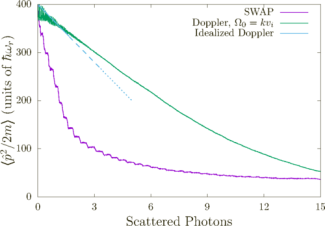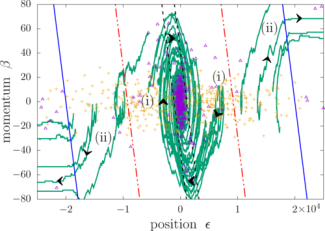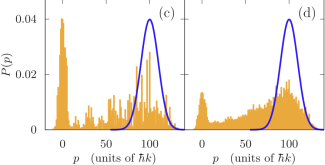The energy removed per scattered photon in sawtooth-wave adiabatic passage cooling compared to Doppler cooling.
Simulated phase space trajectories of neutral atoms in a novel magneto-optical trap that utilizes sawtooth-wave adiabatic passage.
Snapshots of the initial (blue) and final (orange) momentum distributions of a narrowline slowing procedure. The laser frequency and intensity profiles are constructed using an adiabatic shortcut based on Lewis-Riesenfeld invariant theory. We examine both closed (left) and open (right) dynamics of the protocol for parameters relevant to several commonly used atomic and molecular optical transitions.
J. Bartolotta, J. Reilly & M. Holland, PRA 102, 043107 (2020)
Ultracold ensembles provide test beds for exploring fundamental physics, can create low-temperature superfluids such as Bose-Einstein and fermionic condensates, and can be used as platforms for quantum simulations. Therefore, nearly all AMO experiments have a preliminary stage to slow and cool a particle ensemble as it leaves an atom or molecule source. Our group’s research focuses on cavity-assisted and synchronization-assisted cooling in optical cavities and the slowing and cooling of narrowline particles in free space systems. The former has lead to proposals of supercooling via collective synchronization, while the latter is an important practical consideration as traditional schemes, such as Zeeman slowing and Doppler cooling, rely on spontaneous emission. For narrowline transitions, this necessarily requires large slowing distance and long cooling times, along with other considerations such as leakage to states not addressed by the system’s lasers and momentum diffusion due to the random direction of spontaneously emitted photons. These issues make methods that increase slowing and cooling forces and minimize the number of scattering events through enhanced control of tailored coherent dynamics enticing candidates to create ultracold ensembles of narrowline particles.
Our group along with the Thompson lab have pioneered a novel cooling method of narrowline particles called sawtooth-wave adiabatic passage (SWAP) cooling. Here, particles are coherently driven between ground and excited states of an optical transition by counterpropagating, frequency-swept lasers. Spontaneous emission is still critical in order to remove entropy from the system to achieve steady-state cooling, but by coherently driving a particle between its ground and excited state multiple times, large amounts of energy can be removed per spontaneous emission. We have further demonstrated how to implement the SWAP cooling procedure in a one-dimensional magneto-optical trap (MOT) to cool, slow, and trap particles with fewer spontaneously emitted photons, with higher forces, and in less time when compared to a traditional MOT scheme. We have also developed a narrowline particle slowing protocol utilizing adiabatic shortcuts to speed up the slowing dynamics and reduce the effects of spontaneous emission even further. On top of this work on nearly coherent schemes, our group has collaborated with the Ye lab to develop a three-dimensional generalized cooling simulation to model gray molasses cooling in complicated molecular structures.





 The Physics Frontiers Centers (PFC) program supports university-based centers and institutes where the collective efforts of a larger group of individuals can enable transformational advances in the most promising research areas. The program is designed to foster major breakthroughs at the intellectual frontiers of physics by providing needed resources such as combinations of talents, skills, disciplines, and/or specialized infrastructure, not usually available to individual investigators or small groups, in an environment in which the collective efforts of the larger group can be shown to be seminal to promoting significant progress in the science and the education of students. PFCs also include creative, substantive activities aimed at enhancing education, broadening participation of traditionally underrepresented groups, and outreach to the scientific community and general public.
The Physics Frontiers Centers (PFC) program supports university-based centers and institutes where the collective efforts of a larger group of individuals can enable transformational advances in the most promising research areas. The program is designed to foster major breakthroughs at the intellectual frontiers of physics by providing needed resources such as combinations of talents, skills, disciplines, and/or specialized infrastructure, not usually available to individual investigators or small groups, in an environment in which the collective efforts of the larger group can be shown to be seminal to promoting significant progress in the science and the education of students. PFCs also include creative, substantive activities aimed at enhancing education, broadening participation of traditionally underrepresented groups, and outreach to the scientific community and general public.